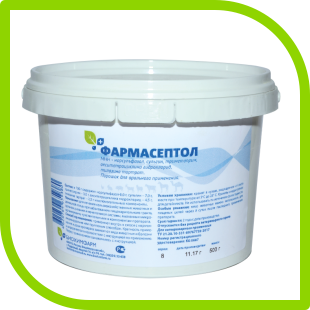INSTRUCTION
use Pharmaseptol for the treatment of farm animals and poultry (chickens, turkeys, ducks, geese) diseases of bacterial etiology
(Organization-developer: OOO Firma “Biokhimfarm”, 600910, Vladimir region, rainbow, block 16, and/I 74)
I General information
1. Trade name of the medicinal product: Farmacity.
International nonproprietary name: norsulfazol, sulgin, trimethoprim, oxytetracycline hydrochloride, tylosin tartrate.
2. Dosage form: powder for oral administration. Pharmasepa as active ingredients 100 g contains norsulfazol – 8,0 g, sulgin – 7.0 g, trimethoprim-3.0 g, oxytetracycline hydrochloride -4,5 g, tylosin tartrate and 2.5 g and auxiliary components.
3. In appearance, the drug is a homogeneous water-soluble powder of light yellow color with a weak specific smell. Shelf life of the drug under storage conditions – 2 years from the date of production. Do not use Pharmasepa after the expiration date.
4. The drug is available packaged in 12 g, 50 g, 100 g, 200 g, 500 g, 1 -10 kg in hermetically sealed polymer cans, or in plastic bags.
5. Store the drug in a closed package of the manufacturer away from heating devices, away from food and feed, in a dry, protected from direct sunlight at a temperature of 5° C to 25°C.
6. Pharmaceptol should be stored out of reach of children.
7. Unused drug with expired shelf life is disposed of in accordance with the requirements of the legislation.
8. Released without a veterinarian’s prescription.
II. Pharmacological properties
9. Pharmacotherapeutic group of the drug: antimicrobial drugs in combination.
10. Pharmasepa – comprehensive drug broad spectrum bactericidal and bacteriostatic action.
Tylosin tartrate is a macrolide antibiotic. Effective against gram-positive and some gram-negative microorganisms (Corynebacterium spp., Clostridium spp., Erysipelothrix spp., Pasteurella spp., Vibrio spp., Leptospira spp., Brucella spp., Neisseria spp., Haemophilus spp.), as well as against Rickettsia (Rickettsia spp.), spirochaetes (Spirochaetes) and against mycoplasmas (M. gallisepticum, M. synoviae, M. meleagridis, etc.). Tylosin tartrate exhibits bacteriostatic effect by inhibiting protein synthesis (by irreversible connection with the 50s subunit of bacterial ribosomes) and, accordingly, the growth and reproduction of microbial cells.
Norsulfazol – antimicrobial bacteriostatic agent. Active against gram-positive and gram-negative microorganisms: E. coli, Shigella spp., Klebsiella spp., Vibrio cholerae, Clostridium perfringens, Bacillus anthracis, Corynebacterium diphtheriae, Yersinia pestis, Chlamydia spp., Actinomyces israelii, Toxoplasma gondii.
Sulgin – antimicrobial sulfonamides bacteriostatic substance. The mechanism of action is due to the competitive inhibition of dihydroperoatsintetase, which leads to a violation of the synthesis of tetrahydrofolic acid, necessary for the synthesis of purines and pyrimidines.
Oxytetracycline is a bacteriostatic antibiotic, the mechanism of action of which is to disrupt the synthesis of protein in its interaction with ribosomes, as well as to reduce the permeability of the cytoplasmic membrane of sensitive microorganisms. The drug has a wide range of actions against gram-positive and gram-negative microorganisms: Streptococcus spp., Clostridium spp., Corynebacterium spp., Brucella spp., Haemophilus spp., E. coli, Pasteurella spp., Klebsiella spp., Fusobacterium spp., Salmonella spp., and also affects protozoic (Protozoa), Mycoplasma (Mycoplasma spp.), Rickettsia (Rickettsia spp.) and chlamydia (Chlamydia).
Trimethoprim is a chemotherapy drug that has a bactericidal effect against gram-positive (Staphylococcus spp., Streptococcus spp., Clostridium spp., Corynebacterium spp. and others) and gram-negative (E. coli, Salmonella spp., Klebsiella spp., Proteus spp., Pasteurelia spp., Bordetella spp. etc.) microorganisms. It inhibits bacterial reductase, which converts dehydrofolic acid into tetrahydrofolic acid, which is a necessary compound for the synthesis of purines and nucleic acids.According to the degree of impact on the body Farmaseptol on the degree of impact on the body refers to moderately hazardous substances (hazard class 3 according to GOST 12.1.007).
III. The order of application
11. Pharmaceptol is used for the treatment of farm animals and poultry in diseases of the digestive tract, respiratory system and genitourinary system caused by microorganisms sensitive to the components of the drug:
-calves, camels, patients with gastroenteritis, salmonellosis, pasteurellosis, vibriosis;
-foals, rabbits, patients with gastroenteritis, salmonellosis, pasteurellosis;
-pigs with enzootic pneumonia, arthritis, dysentery, edema, erysipelas, salmonellosis, pasteurellosis;
-sheep with septicaemia, eimeriosis, infectious agalactia;
-poultry (chickens, turkeys, ducks, geese), typhoid, cholera, salmonellosis, mycoplasmosis, rhinitis.
12. Do not use for the treatment of animals with hypersensitivity to norsulfazole, tylosin, oxytetracycline, sulgin, trimethoprim, as well as liver and kidney diseases. It is forbidden to use for treatment of dairy animals which milk is used in food to people, and laying hens which eggs are used in food to people.
13. The drug is administered orally in a mixture with feed.
Treatment of pigs, poultry and rabbits is carried out mainly by the group method by evenly mixing the daily amount of feed with the drug. To 100 kg of pigs – 300-350 g, poultry and rabbit 400 g of the drug.
For all types of daily dose is 1.0–1.2 g per 10 kg of body weight. The daily dose is given in two doses. Depending on the state of the disease at first use, dose of Pharmacopeia can be increased by 30-100%.
Treatment is carried out until the complete disappearance of the clinical symptoms of the disease and can be extended for 1-2 days.14. Symptoms of overdose in animals were not identified.
15. The specific effects of the medicinal product at first use or withdrawal thereof: not applicable.
16. The use of Pharmacopeia no negative impact on pregnancy, lactation and development of offspring in animals.
17. You should avoid missing the next dose of the drug, as this can lead to a decrease in therapeutic effectiveness. If you accidentally increase the interval between two injections of the drug, it should be administered as soon as possible.
18. When applying Pharmacopeia in accordance with this instruction side effects and complications are usually not observed. With an increase in the period of application may cause vomiting, diarrhea, crystalluria.
With increased individual sensitivity of the animal to the preparation components and the development of allergic reactions the use of the drug is stopped and desensitizing therapy.
19. The use of Pharmacopeia does not preclude the use of other drugs.
20. Slaughter of animals and poultry for meat is allowed 8 days after the last use of the drug. The meat received before the specified term is utilized or fed to unproductive animals depending on the conclusion of the doctor of veterinary medicine.
IV. Personal prevention measures
21. When working with the drug should follow the General rules of personal hygiene and safety provided when working with drugs.
22. When working with Tarmacadam do not drink, smoke and eat. Avoid contact with the skin and mucous membranes. After working with the drug should wash your hands with soap. Empty containers from the drug may not be used for domestic purposes.
23. In case of accidental contact of the drug with the skin or mucous membranes, rinse immediately with plenty of water. In case of allergic reactions or accidental ingress of the drug into the human body, you should immediately contact a medical institution (you should have the instructions for use of the drug and the label).






